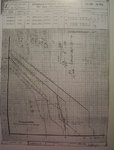CORSNING
Tech Sergeant
davparir,
I read the report on 44-1 fuel that you posted. It said the merlin 66 in the Mk.IX was cleared for +25 and the Mk.XIV was cleared for +21 boost. I saw the general statement."It is understood that the maximum permissible boost pressure in these engines is plus 25-lbs per sq.inch". The statement was saying that of all the engines tested safely, that +25 boost was the maximum permitted in ANY of them. Not ALL of them.
Later Griffon engines were cleared for +25 boost, but not the Griffon 61/65. At least not for combat durring WW2. It was tested extensively in hopes of catching V-1s though.
I know that the Mk.VIII with the Griffon installed was capable of around 5,100fpm. That was a prototype for the Mk.XIV. I believe the maximum climb rate of the Spit 14 at +21 is somewhere in the middle of 4,700-5,100fpm. Like I said, I have not seen figures or graph showing the climb rate of the Mk.14 at +21 boost. I would love to though.
I'm agreeing with Vincenzo on this one.
Oh, and one last thing The F4U-4's figures in clean (no pylons) are: 383mph/SL AND 4,770fpm/SL. (actually the climb rate is with the double clip wing pylons). Apples to apples and interceptor to interceptor.
I read the report on 44-1 fuel that you posted. It said the merlin 66 in the Mk.IX was cleared for +25 and the Mk.XIV was cleared for +21 boost. I saw the general statement."It is understood that the maximum permissible boost pressure in these engines is plus 25-lbs per sq.inch". The statement was saying that of all the engines tested safely, that +25 boost was the maximum permitted in ANY of them. Not ALL of them.
Later Griffon engines were cleared for +25 boost, but not the Griffon 61/65. At least not for combat durring WW2. It was tested extensively in hopes of catching V-1s though.
I know that the Mk.VIII with the Griffon installed was capable of around 5,100fpm. That was a prototype for the Mk.XIV. I believe the maximum climb rate of the Spit 14 at +21 is somewhere in the middle of 4,700-5,100fpm. Like I said, I have not seen figures or graph showing the climb rate of the Mk.14 at +21 boost. I would love to though.
I'm agreeing with Vincenzo on this one.
Oh, and one last thing The F4U-4's figures in clean (no pylons) are: 383mph/SL AND 4,770fpm/SL. (actually the climb rate is with the double clip wing pylons). Apples to apples and interceptor to interceptor.
Last edited:

